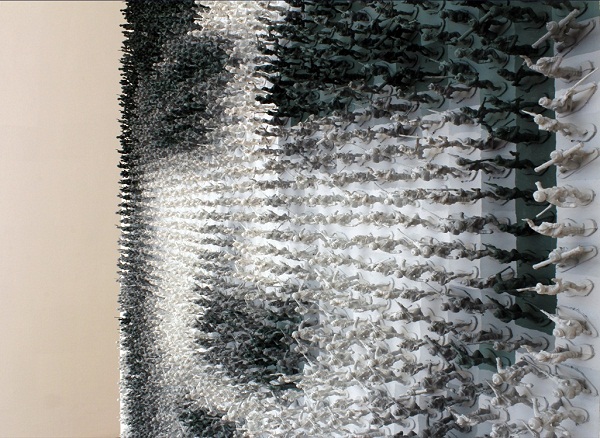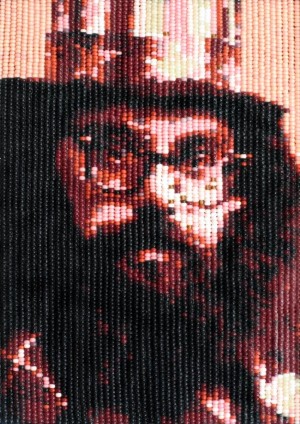Artist of the Week 8/29 – 9/4: Jean-Pierre Séguin Creates Abstract Work with a Concrete Context
GALO: One of the main purposes of your portraits is to throw off the viewer’s perception of reality through the use of three-dimensional pieces — buttons, army men, beads, etc. The viewers of your works accomplish this perspective themselves by moving closer to the portrait, slowly losing grip of the portrait as a whole. Why leave it up to the viewer to do this? Why not just make your art abstract at first glance?
JS: To get his attention, the viewer must feel involved and should be surprised. I like to see that the viewer moves forward and backward in front of my work — he checks his perception and understanding of the portraits. I always approached the painting in the possibilities of abstraction and reality. For me, this is not an opposition, but complementary. It’s like watching nature in reality and looking at [it] under a microscope. Our vision in the microscope seems abstract, but it is real, and it is more small particles that make up our reality.
GALO: In a similar vein, portraits inherently mean the representation of a single object or individual; but your art is made up of millions of pieces, each with its own individual quality (especially your Peace and Love portrait, made up of thousands of toy soldiers — one of my favorites). How do you balance these two opposite qualities in your work?
JS: For me, it is a whole, they are not severable. Every picture’s elements have the same importance. These are the elementary particles that make the portraits; but I’m still looking for the Higgs boson [elementary particle].
GALO: You say in your abstract that “I photograph contemporary artists to pay them homage, but also because it allows me to play on the identification of the represented individual” by capturing their anthropometric features. Certain subjects have more recognizable features than others — like Woody Allen’s dark rimmed glasses or Marilyn Monroe’s hair. Is it harder to play with the identity of these more famous individuals?
JS: Yes, you’re right. But according to the distance of the portrait, your perception of identity disappears. Up close, you see the objects that are the portrait and you lose the identity of the person represented. Everything is a matter of distance and perception.
A portrait of Marilyn Monroe by Jean-Pierre Séguin. Photo Courtesy of: Jean-Pierre Séguin.
GALO: Though much of your artistic process is dedicated to recreating original photographs into their final “assemblage” stage, you also have had to develop the unique skill of being able to take a good picture of someone — which can be very difficult. Have certain contemporary artists been more difficult to photograph than others?
JS: The artists are very nice; I’ve never had a problem. I ask the person to be natural and have a neutral expression. I am looking for a great simplicity in these photographs. I’m closer to the objective photography and away from the photography campaign poster.
GALO: One of your portraits is made out of 3,000 beads. Another is made of thousands of puzzle pieces, and your Peace and Love portrait is made of toy soldiers. Where do you get such a large number of these materials? Do you acquire them over time?
JS: This is different for each portrait. For parts of the puzzle, I bought hundreds of puzzles in flea markets. Preferably puzzles that were incomplete — it was cheaper. The plastic soldiers were purchased on the Internet about eight years ago. The beads are purchased at a specialty store. With the generous support of Canadian Buttons Limited, I also created a portrait using some 3,000 custom-made buttons.

The detail of Jean-Pierre Séguin’s “Peace and Love” piece. Photo Courtesy of: Jean-Pierre Séguin.
GALO: In the last line of your artist’s statement you say, “I am looking for something very concrete in the context of abstract work.” For me, it seems that it could also be said the other way around — finding something very abstract in the context of concrete work, or photography. Are you looking for this as well? Can you disentangle the concrete from the abstract in your work?
JS: You’re right; it is possible to find abstraction in photography. What I mean is that when I [build] the portrait, I always work in the abstract. I am very close to the image and I work with elements, not realistic representation. The portrait is realistic but the elements used (beads, puzzle piece, etc.) to make it, are not necessarily representative. My work is always a back and forth between the realistic and the abstract or between abstract and realistic.
GALO: Are you planning on continuing to explore portraiture or do you have an interest in other genres? Will your upcoming works also be assemblages of portraits?
JS: The portrait has always been a favorite subject for me and I do not think I made the rounds of the subject. I have other ideas for assembly and I hope to make them soon. Meanwhile, I am working on sculpture projects, projects in painting, and photography projects. The portrait occupies an important place in my work, but I like to explore other topics. The important thing is to have a good idea and be able to achieve it, no matter the subject.


